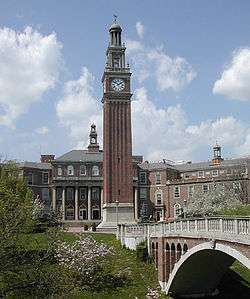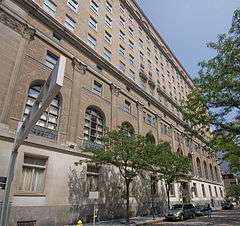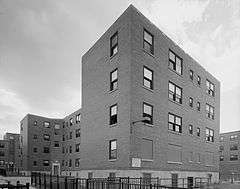Frederick W. Garber


Frederick W. Garber (1877–1950) was an American architect in Cincinnati, Ohio and the principal architect in the Garber & Woodward firm with Clifford B. Woodward (1880–1932).[1] The firm operated from 1904 until it was dissolved in 1933[1] Their work has been described as in the Beaux-Arts tradition and included buildings on the University of Cincinnati campuses, schools, hospitals, commercial buildings, "fine residences" and public housing.[1]
Background
Garber was the eldest son of Frederick H.C. Garber who was born in Hanover Germany and worked at a German newspaper. [2] Garber and Woodward were students together, business partners in their architectural firm, and brothers-in-law. They attended Cincinnati Technical School, worked as draftsmen for Elzner & Anderson in Cincinnati; and attended a two-year course in architecture at M.I.T. (studying with Beaux-Arts-trained Professor C.D. Despradelle).[1] Garber won a Rotch Scholarship and studied abroad. He may have traveled with Bertram Goodhue while in Europe, as well as with a partner in the firm of Cass Gilbert.[1]
Woodward was born in the Walnut Hills area of Cincinnati and spent most of his life in the Glendale section of town. He was the third son of Henry L. Woodward who worked for First National Bank.[2]
Garber was a fellow of the AIA and a member of its Board of Directors, a member of the Corporation of M.I.T., and a member of the visiting committee of the art and archaeological department of Princeton University.[1]
Firm
The Garber & Woodward firm's design for Withrow High School (1915–1919) at 2488 Madison Road in Hyde Park included "an agricultural section with conservatories and a poultry house, a manual-training shop, and a fine gymnasium" on a 30-acre (120,000 m2) campus [1] Garber & Woodward "made the difficult challenge of a ravine across the front of the site into a dramatic asset by means of a Palladian bridge leading to the tall bell tower, which resembles the campanile in St. Mark's Piazza in Venice. The main building is graceful, balanced composition with horizontal lines. Two matching wings are attached at a slight angle so that they spread across the wide entrance court to embrace the visitor."[1]
The firm collaborated with Cass Gilbert and John Russell Pope of New York on the design of the Union Central Life Insurance Co. Building (now the PNC bank building) and on the Cincinnati Gas & Electric Co. (Cinergy/Duke Energy) headquarters (Duke Energy Building).[1]
Garber & Woodward designed the Phelps Apartment House (The Phelps) at 506 East Fourth Street for the Taft family and remodeled the Baum-Longworth-Sinton-Taft House as the Taft Museum, after the deaths of Charles Phelps and Anna Sinton Taft (ca. 1930).[1] The firm "restored much of the Victorianized interior according to a fairly authentic but Deco-flavored Federal style."[1] The firm also designed the Anna Louise Inn for Girls (originally the Union Bethel) on Pike St. near the Taft Museum and a work that may have been carried out in association with Elzner & Anderson. Mr. and Mrs. "Charles P. Taft" also funded construction of the operation for the Cincinnati Union Bethel (CUB) to run a non-profit offering 120 "working young women, who had come to Cincinnati seeking employment from various rural areas, both security and affordable housing" on Third and Lytle streets.[3]
During the Great Depression F.W. Garber was head of the Associated Architects responsible for the design of the early WPA Projects: Laurel Homes and Lincoln Court (formerly on Ezzard Charles Drive) west of Music Hall (replaced by City West ca. 2002-2003), and later the English Woods and Winton Terrace housing projects.[1]

Garber's firm designed the Phoenix Building, now known as the Cincinnati Club, a 1924 former hotel and private club in Cincinnati, Ohio that is now used as a banquet hall. It was listed in the National Register on January 11, 1985[4] and is also recognized as a historic landmark by the Miami Historical Preservation Association.[5]
The firm's Chamber of Commerce Building on 1-11 Capitol Street in Charleston, West Virginia was later demolished. It was a six floor rigid frame steel structure user as a commercial office.[6]
The nine-story Vernon Manor Hotel was built in 1924 the Avondale neighborhood "for wealthy Cincinnatians longing to get away from the hustle and bustle of downtown". Perched atop one of the cities' Seven Hills it overlooks the city skyline. It was featured in the 1986 film Rainman starring Tom Cruise and Dustin Hoffman.[7]
Garber & Woodward were involved in planning with landscape architect John Nolen for a recreation center in the Mariemont project development, "an essential component" but after Nolen's services were terminated the commission was never fulfilled, and it was designed by New York architect George B. deGersdorff instead who was an old classmate and friend of Charles Livingood. Architect Edward Kruckemeyer worked with Garber & Woodward for a time before joining with another MIT classmate, Charles Strong in 1915 after they traveled together in Europe.[8]
Garber practiced with John Postler and Lawrence Lefken from 1933–1938 and on his own from 1939-1952.[1] His son Woodie (Woodward) Garber also had a firm "with a more contemporary approach" from 1949-1971.[1]
Legacy (Woodie Garber)
Frederick William Garber's son Woodie Garber (often spelled Woody) took a more contemporary approach to architecture. He designed Cincimnati's first post World War II main library building at the corner of Eighth and Vine using a plan with a lot of open space. The building is "the cornerstone of the present Main Library complex".[9] He also designed Sander Hall at the University of Cincinnati (since imploded). He also authored a 1973 guide called "An architectural program for adult corrections facilities for Cincinnati and Hamilton County".
Projects
- Main Library building, Cincinnati [10]
- Moore House in Cincinnati, a 5,160-square-foot (479 m2) wood-and-glass house on a 5.4-acre (22,000 m2) site (1952). It was being video taped, documented and salvaged prior to demolition in 2007.[11]
- Woodie Garber residence Glendale, Ohio[12]
- Procter Hall, University of Cincinnati (1968), used for the College of Nursing.[13]
- All Saints Chapel addition, Christ Church Glendale (1959–1960)[14]
Frederick W. Garber and Woodward & Garber projects

Residences, churches, and other buildings
- William Cooper Procter's Glendale, Ohio residence (1904) and his summer house in Devon, L.I. (1909).[1]
- Anna Louise Inn (1909) on the 300 block of Lytle Street in Cincinnati's central business district, a five-story concrete and brick building for women who came to Cincinnati to find employment
- Price Hill Library (1909) at 3215 Warsaw Avenue is a French Renaissance style brick and limestone building with a tin decked roof withslate slopes, fleur-de-lis grid over the doors, bird-head door handles, and cherry wood shelves. It was funded by the Andrew Carnegie Foundation,[15] and is a branch of the Public Library of Cincinnati and Hamilton County system.
- Avondale Library (1913) in Cincinnati, a Spanish Colonial style building featuring a Rookwood tile entry, decorative iron work, and a domed ceiling. A Rookwood drinking fountain was presented to the branch by the Avondale Improvement Association to mark its opening at 3566 Reading Road. It was funded by the Andrew Carnegie Foundation[16][17]
- Taft Museum (ca. 1930) remodel of the residence into a museum.[18]
- Bethlehem Methodist Church (now Calvary United) in Evanston, a "somewhat austere but handsome and site-specific work in the Collegiate Gothic Revival style"[1]
- Christ Church Episcopal Chapel, Fourth Street[1]
- Elks Temple (later Crosley Square, but now home to a charter school), NEC Ninth and Elm streets.[1]
- Aurora Public Library, a Renaissance style building at 414 Second Street in Aurora, Indiana. Listed on the National Register of Historic Places in 1993.[19]
- additions to J.W. McLaughlin's Cincinnati Art Museum including the Emery, French, and Hanna wings [1]
- Addition to Herbert Greer French House (1930), expanded the east addition after demolition of a smokehouse and a greenhouse.
Commercial and apartment buildings
- F. W. Woolworth Building in Lexington, Kentucky
- Phoenix Building/Cincinnati Club (Piatt Park Center) an 11-story neo-classical building designed by Garber & Woodward with Samuel Hannaford & Sons (1924)[21]
- Dixie Terminal Building (1921) on Fourth Street in downtown Cincinnati including a "superb Adamesque barrel vault" [1]
- The Vernon Manor Hotel (1924), a nine-story English Renaissance Revival "modeled after the stately Hatfield House in England" on the 400 block of Oak Street in Cincinnati's Avondale neighborhood. Renovated in 1999.[7][22]
- Laurel Homes Historic District list on the National Register of Historic Places in 1987. (mostly demolished in 2002)[1]
- Several public buildings in Wyoming, Ohio (near Glendale)[1]
- Milford, Ohio National Bank[1]
- Chamber of Commerce Building in Charleston, West Virginia[1]
- Cincinnati Gas and Electric Building (1929) on East Fourth Street and Main Street in Cincinnati, an 18-floor Neoclassical building designed with John Russell Pope[23][24]
- Phelps Apartment House (The Phelps), a 13-floor beaux-arts apartment building on the 500 block of East Fourth Street (1926)[25]
Schools
- Walnut Hills High School, "based on Thomas Jefferson's University of Virginia Rotunda" in Walnut Hills overlooking Victory Parkway in Evanston (1929–1931)[1]
- Western Hills High School [1]
- Westwood Public School (1909) (now Westwood Elementary and undergoing renovation)[1]
- Guilford School on E. Fourth St. opposite Lytle Park (1911)
- Frederick Douglass and Rothenberg Schools (1914), and a High School in Lexington, Kentucky.[1]
- Withrow High School (1919) on Madison Rd. opposite Erie Avenue [1]
- Rothenberg School was named after Louis Rothenberg its first principal.[26]
University of Cincinnati buildings
- Nippert Stadium (1912) (since remodeled) [1]
- Dyer Hall (1931) at the University of Cincinnati, a wing of the Teachers College[23]
See also
References
- 1 2 3 4 5 6 7 8 9 10 11 12 13 14 15 16 17 18 19 20 21 22 23 24 25 26 27 28 29 30 Frederick W. Garber Dictionary of Cincinnati Architects, 1788-1940 Architectural Foundation of Cincinnati
- 1 2 Charles Frederic Goss [Cincinnati, the Queen City, 1788-1912], Volume 3 Clarke, S. J., publishing company Editor: Charles Frederic Goss, 1912 Original from the New York Public Library Digitized Feb 27, 2008
- ↑ Anne Louise Inn
- ↑ National Park Service (2007-06-30). "National Register Information System". National Register of Historic Places. National Park Service.
- ↑ "The Cincinnati Club History". The Cincinnati Club. Retrieved 2009-06-07.
- ↑ Chamber of Commerce Building Emporis
- 1 2 Vernon Manor Hotel Historic Hotels
- ↑ Millard F. Rogers John Nolen & Mariemont: building a new town in Ohio
- ↑ Cincinnati Library website
- ↑ chronograph Cincinnati Library
- ↑ Margaret Foster Two Modern Houses in Cincinnati Face Demolition Jan. 23, 2007 National Trust for Historic Preservation
- ↑ Woody Garber residence
- ↑ "Built in 1968 by architect Woodie Garber, Procter Hall is currently home to the UC College of Nursing. The building, named after William Cooper Procter, a benefactor and grandson of one of the founders of the Procter & Gamble Co., serves as the gateway to the East Campus. Procter Hall features Garber's unique modern-style architecture, including a large circular staircase made of steel with oak treads in the interior of the building." Academic Health Center Buildings University of Cincinnati
- ↑ "In 1959-60, under the direction of Cincinnati architect Woodie Garber, All Saints Chapel, with space for about 100 persons, was added, along with offices and classrooms. This addition also connected the parish house and main church by a glass corridor, with an entrance colloquially known as the "Whale's Mouth."" Christ Church Glendale website
- ↑ Price Hill Library Cincinnati Library website
- ↑ Avondale Library Cincinnati Public Library
- ↑ Photo of library entryway (Rookwood tile?)
- ↑ The Taft Museum
- ↑ Aurora Public Library (added 1993 - Building - #93000474) Also known as 029-029-51027
- ↑ Herbert Greer French House
- ↑ Piatt Park Center Emporis
- ↑ The Vernon Manor Hotel
- 1 2 Garber & Woodward Emporis
- ↑ Duke Energy Building Emporis
- ↑ The Phelps Emporis
- ↑ Robert and Jean Rothenberg American Jewish Archives
Further reading
- Cincinnati Times-Star obituary 8/7/1950;
- Cincinnati Enquirer obituary 8/8/1950;
- Goss, III (1912), 951-52;
- Menefee (1926), 73;
- Langsam (1997), 19, 71, 128, 154;
- Painter, Sullebarger, AIC (2006), 21, 152, 153, 189, 193, 206, 207, 214, 215, 230;
- Selections from Work Designed and Executed by Garber and Woodward Architects (Cincinnati, Ohio, July 1924);
- Architectural Catalog Co., Main Office, 15 W. 38th Street, New York, Architectural, Engineering, and Building Publications, copy from Woodie Garber archives at Miami University, Oxford, Ohio;
Conversations with Dr. Stanley T. Garber and Woodie Garber, sons of F.W. Garber;
- Christen (April 2008);
- Nuxhall, SGC, 113, Lot 205.